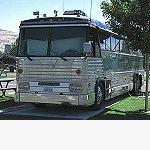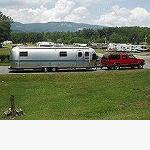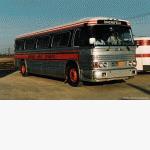| Author | Message | ||
| Roger Baughman (Roger)
Registered Member Username: Roger Post Number: 180 Registered: 11-2006 Posted From: 69.232.68.74  Rating: N/A |
I have an idea for a way to get more air to the engine like a turbo but using a 120 volt A/C through the inverter, blower plumbed in between to filter and the engine air intake. The only time I feel a need for the extra power is on a steep hill climb. I would like to know what the engine experts here think of the idea. All comments are welcome. Thanks, Roger | ||
| FAST FRED (Fast_fred)
Registered Member Username: Fast_fred Post Number: 1274 Registered: 10-2006 Posted From: 99.153.142.249  Rating: N/A |
With no brains , and no mass air sensor , or sensor feed to the engine how would the engine know its got more air , and should squirt more fuel? Look at the Propane setups , Bully Dog and similar if all you want is to fly up some hill. FF | ||
| Austin Scott Davis (Zimtok)
Registered Member Username: Zimtok Post Number: 437 Registered: 9-2006 Posted From: 209.156.24.114  Rating: N/A |
Technically you don't need all of those sensors. There are lots of old buses that don't have all of the sensors and they run Turbos. BUT, An engine that runs a turbo will also have different injectors. And the turbo is in constant use. What Fred is getting at is that if you have a way to turn on and off your boost (remember "Mad Max") you also must have a way to increase your fuel. The "FAN" that your thinking about using will probably not increase your boost much so I don't know what effect it will have on the performance of your engine. If you have black smoke coming out of the exhaust during a hill climb then by adding boost you might get a little cleaner burn. Of course I may be way off base and not know what I'm talking about . . | ||
| JC Alacoque (Jc_alacoque)
Registered Member Username: Jc_alacoque Post Number: 93 Registered: 7-2006 Posted From: 207.34.166.7 Rating: N/A |
When I had my 4-71 before I turboed it, it would smoke if I put my foot to it, especially at altitude. Normal behavior for a natural engine. That is because it doesn't get enough air to burn all the fuel. I built a little scoop for the air intake for ram air effect. It worked great and pretty well eliminated the smoke past 15, 20 mph. Then I installed a turbo on it, and ran it for an intire summer with the only mod being a rebuilt blower with the later, better oil seals that can take the extra boost pressure. Same one piece pistons, inj., valves, etc. It is not untill the winter after that I overhauled the engine to turbo specs. What I am saying is that black smoke is unburned fuel because not enough air getting into the combustion chambers. Any way to get more air in there is a great improvement. Install the fan and leave running all the time. JC | ||
| Tom Christman (Tchristman)
Registered Member Username: Tchristman Post Number: 239 Registered: 1-2006 Posted From: 66.218.33.156 Rating: N/A |
Problem with trying to run a 120vac fan is the amount of air you need to move to get any help from. The 8V-71 flows about 1200cfm, and the 8V-92 about 1500cfm. If you look at the size and amount of power to run such a fan-it is just not practical. Don't you think that if this was a good way to go the engine manufacturers would have developed this technology years ago? Don't waste your time and money on anything electric (this includes electrically powered radiator fans). While some electrical components work on cars, they are just not practical nor do they work sufficiently well on a commercial vehicle. If you want to stop your smoking, either go with smaller injectors or install a "smoke" turbo. Good Luck, TomC | ||
| Kyle Brandt (Kyle4501)
Registered Member Username: Kyle4501 Post Number: 603 Registered: 9-2004 Posted From: 65.23.106.193  Rating: N/A |
Some crude calculations: 8V71 at 2200 rpm ~723cfm If you want ~15lbs boost, that will be ~1475scfm That would require almost 7hp if perfect efficiency. Hmmm, might well be doable. If you do this, please post your results! | ||
| marvin pack (Gomer)
Registered Member Username: Gomer Post Number: 958 Registered: 3-2007 Posted From: 71.55.13.161  Rating: N/A |
Roger, check the air filter also as that caused me some black smoke on an 8V-71 while pulling the mountains in New Mexico and back to Virginia. We did install scoops on the intake and that helped a lot. | ||
| Roger Baughman (Roger)
Registered Member Username: Roger Post Number: 181 Registered: 11-2006 Posted From: 75.13.98.28  Rating: N/A |
Thanks for all of the advice and info. It is much appreciated, Roger | ||
| R.C.Bishop (Chuckllb)
Registered Member Username: Chuckllb Post Number: 1357 Registered: 7-2006 Posted From: 75.211.120.156  Rating: N/A |
I was amazed a couple of weeks ago, in 100 degree plus heat, at just how much extra power I got from a Cummins 220NH with turbo, going up a very long New Mexico hill, from White Sands Missile Base over San Augustin Pass, just by changing the radiator fan from 6 to nine blades...slightly different pitch. (Horton Fan). Horton and Cummins came up with the combination. There is one that is even more aggressive which they also recommended, but I chose not to purchase. Not sure, but I think it was 12 blades!!! Lower temps = more power....I think  (so I am led to believe) (so I am led to believe) RCB | ||
| ED Hackenbruch (Shadowman)
Registered Member Username: Shadowman Post Number: 304 Registered: 11-2003 Posted From: 72.102.109.230 Rating: N/A |
So if you want more air to help burn the fuel when you are climbing a hill, how about an extra air tank or even an Oxygen tank plumbed in so that you could hit a switch for a minute or two when you need it. Think in terms of nitrous bottles in cars but just air or oxygen in the bus. No idea how much a tank of oxygen would run you but an extra air tank run off of your compressor would be basically free. Would this work/be feasible? | ||
| Jack Fids (Jack_fids)
Registered Member Username: Jack_fids Post Number: 128 Registered: 1-2009 Posted From: 69.171.160.36  Rating: N/A |
again it's the fuel delivery amount that needs to remain proportionate, feeding lots of forced air or oxy causes a LEAN mixture, lean mixtures mean melted piston tops, & they're pretty important. You can try to beat the established systems but you'll only waste time & money, better on your bus tho than in Las Vegas ...as for going uphill... there's only 2 people that care if your slow you & the guy behind you who doesn't have the brains or HP to pass. Enjoy the view! | ||
| Tom Caffrey (Pvcces)
Registered Member Username: Pvcces Post Number: 1332 Registered: 5-2001 Posted From: 65.74.67.67 Rating: N/A |
Jack, diesels run leaner than standard mix at every throttle setting that is not full throttle. Burned pistons is more of a gas engine problem, because they can run too lean if they do not get enough fuel with an open throttle, such as a failing fuel pump or a plugged filter. A plugged filter in a diesel can cause injectors and pumps to overheat. For what it's worth. Tom Caffrey PD4106-2576 Suncatcher Ketchikan, Alaska | ||
| Jack Fids (Jack_fids)
Registered Member Username: Jack_fids Post Number: 129 Registered: 1-2009 Posted From: 69.171.160.174  Rating: N/A |
I stand corrected with appreciation! | ||
| FAST FRED (Fast_fred)
Registered Member Username: Fast_fred Post Number: 1277 Registered: 10-2006 Posted From: 99.153.142.249  Rating: N/A |
Lower temps = more power....I think :-) (so I am led to believe) Diesels work most efficiently at the highest temperature you dare operate. With the 1936DD design it doesnt pay to go over 180F as 200 Indicated may have steam pockets in the heads and the cooling suffers.KAPOW The more modern engines in trucks will use 15-18PSI cooling systems and the Evans coolant conversions go to really higher temps. Of course 1/2 a MPG increase might be $10,000 to a truck co , so the high price of fancy coolant can be tolerated. Same for Synthetic oil and aftermarket by pass filtration , only a 1/4 mpg improvement is worth the expense. FF | ||
| Roger Baughman (Roger)
Registered Member Username: Roger Post Number: 182 Registered: 11-2006 Posted From: 69.232.68.74  Rating: N/A |
more air to the engine, should give you more RPM, more RPM more fuel. Where am I wrong here. | ||
| Luvrbus (Luvrbus)
Registered Member Username: Luvrbus Post Number: 921 Registered: 8-2006 Posted From: 74.32.80.29 Rating: N/A |
The governor controls the rpm not the air or fuel if you are seeking air more check the blower numbers to see which model you have they are like ice cream lots to choose from, the blower gear ratio also play a part, if you have a 2.05:1 gear ratio change to 1.95:1 or turbo the engine. good luck | ||
| ED Hackenbruch (Shadowman)
Registered Member Username: Shadowman Post Number: 305 Registered: 11-2003 Posted From: 72.102.177.156 Rating: N/A |
I was thinking that more air would be a better burning of fuel which would mean less or no black smoke, less waste of fuel, and more power out of the same amount of fuel. | ||
| FAST FRED (Fast_fred)
Registered Member Username: Fast_fred Post Number: 1279 Registered: 10-2006 Posted From: 99.153.142.249  Rating: N/A |
No question that black smoke is OVERFUELED for the air supply , but putting a fan on the intake isnt going to do a lot. The most modern Euro diesels use dual turbos , a small puppy to help the lower speed power , and a nice big jobby for the 6000rpm up boost.Loads of air at every speed. Best thing you can do for our antiques is loads of cool fresh clean air. IF black smoke is constant under heavy loads some joker put in DE FUELER injectors , a total waste of time and money. With the air supplied by the blower , at any RPM there is only so much fuel that can be combusted , add extra , loose power, make smoke. But at least the black smoke is "Bucky Balls" (after Buckminister Fuller) is a rare phenominom ,worth looking at with your kids microscope. FF | ||
| George M. Todd (George_todd)
Registered Member Username: George_todd Post Number: 1085 Registered: 8-2006 Posted From: 99.56.240.204 Rating: N/A |
Roger, Putting more air into a properly operating engine, with no other modifications, won't do a thing. If it would, the manufacturers would have done it already. A fan in the air intake would cause restriction when not in use. The required horsepower estimate above is also correct. In an engine that smokes black under heavy throttle, which means unburned fuel being exhausted, adding more combustion air would indeed increase power and fuel economy. See JC Alacoque's post above, which is correct. A turbo uses the WASTE energy in the exhaust gas to pressurize the air going into the intake manifold, WHICH THEN ALLOWS THE USE OF LARGER INJECTORS TO INJECT MORE FUEL, BECAUSE MORE AIR TO BURN IT IS AVAILABLE! Hence the requirements for stronger pistons, etc, and a larger cooling system, because more fuel is being burned to produce more power. Turbo pistons have a lower compression ratio, because of the pressurized air entering the cylinder causing higher compression pressure. We do indeed see more boost pressure on a turbocharged engine as more throttle is applied, as more exhaust gas is produced because more fuel is burned, which turns the turbo faster. Turbo pressure increases as outside temperature decreases, because the air is denser, and will be highest at full throttle, just below maximum governed speed, when the governor starts to limit fuel to prevent over-speed. So, you could put a fairly mild turbo on your "naturally aspirated" engine, with no other modifications, and get a little better fuel mileage, better power, especially at higher altitudes, and get rid of any black smoke. Changing pistons, and larger radiators are not required, because you are not enlarging the injectors. Actually the engine will run cooler, as more air is pushed through it, which will take more heat out the exhaust, which reduces the load on the radiators. G | ||
| George M. Todd (George_todd)
Registered Member Username: George_todd Post Number: 1086 Registered: 8-2006 Posted From: 99.56.240.204 Rating: N/A |
Luvrbus, The governor is connected to the injector linkage, also known as the fuel rack. It controls engine speed by varying the amount of fuel injected. It also stops the engine by moving the rack to the no fuel position when the stop lever is actuated by the Skinner valve and shutdown cylinder. Ed is exactly right, and posted quickly what I spent a lot of time explaining above. G (Message edited by George_todd on August 14, 2010) | ||
| Larry & Lynne Dixon (Larry_d)
Registered Member Username: Larry_d Post Number: 268 Registered: 7-2005 Posted From: 71.117.168.182  Rating: N/A |
George really enjoyed your post. Question from a dummy how would I know a fairly mild turbo. PO of my 4905 said (I think 65 injectors) were installed when engine rebuilt to be able to use a turbo. Does this sound reasonable? Thanks for the indepth info. Larry | ||
| Luvrbus (Luvrbus)
Registered Member Username: Luvrbus Post Number: 922 Registered: 8-2006 Posted From: 74.32.80.29 Rating: N/A |
George, I know how the DD works he thought by adding air it would increase the rpm that is not going to happen without changing the governor setting | ||
| Roger Baughman (Roger)
Registered Member Username: Roger Post Number: 183 Registered: 11-2006 Posted From: 69.232.68.74  Rating: N/A |
First, I do not have black smoak after the engine warms up. I am just looking for a way to increase my steep hill speed without spending a lot of money. Adding a turbo is expensive. Fast Fred said "Best thing you can do for our antiques is loads of cool fresh clean air". Well then what about a intercooler to supply the air cleaner of cool air? Thanks again for all of your comments and advice, Roger | ||
| George M. Todd (George_todd)
Registered Member Username: George_todd Post Number: 1089 Registered: 8-2006 Posted From: 99.56.240.204 Rating: |
First off, there are NO dumb questions! I mean it! Its far better to ask than to do something wrong, and at best just have to do it over, at worst, fix something that broke! There's no limit on questions here either, for a reason. So, burning fuel, whether its wood, coal, or diesel, takes a heat source to ignite it, and oxygen for it to burn. The high compression pressure of a diesel engine raises the air temperature in the cylinder high enough that when the fuel is injected, it burns immediately. Now all we have to do is get enough air into the cylinder to properly burn the amount of fuel injected... This happens "by accident" with a 4 stroke non-turbo (aka naturally aspirated) engine, just by the air taken in on the intake stroke. The injector size is limited to inject only the amount of fuel that can be burned by the air present. Adding a turbo to that engine will allow the use of larger injectors, because now the intake manifold is pressurized, and will push air into the cylinders, resulting in a few pounds of air pressure at the bottom of the intake stroke, insted of a small vacuum. Most of the same applies to our 2-stroke DDs, except they need the blower to breathe them. Adding a turbo to the early engines pressurizes the blower, which adds more air to the engine by doing away with the leakage loss around the lobes, and giving the blower pressurized air to push, so it pushes more. Now, its splitting hairs, but the blower by itself consumes a few horsepower. With a turbo pressurizing the blower, it actually adds a couple of horsepower to the engine thru the gear drive, at heavier throttle. Then we have the later 92s with a bypass valve, which lets the turbo push a whole lot more air into the cylinders, around the blower. Since the engine now has lots more air, larger injectors can be installed, to inject more fuel, and produce more power. More fuel injected means more heat, which is rejected two ways. 1. Thru the exhaust, due to the more air. 2. Thru the radiators, enough said. "Turbo" pistons need to be stronger, because they are doing more work, and also to have a lower compression ratio, as they now have to compress a cylinder full of pressurized air, instead of essentially zero. Installing certain # injectors "...So a turbo could be installed later..." sounds a little like a selling point to me. If they're bigger than "stock," the engine will smoke black under heavy throttle all the time, there's just no way around it. The comments on blower gear ratio above are correct, air is free. Increasing the blower speed is the only halfway easy thing to do for smoke reduction, and the resultant increase in power and economy. In my opinion, a turbo can be added to our engines without changing pistons, as long as the injectors aren't increased. The blower being in the way is enough of a restriction to prevent over-pressurizing the engine. I'm sorry, but I don't have numbers on turbos, but the DD dealers will. An intercooler has to have HOT air pushed thru it to give off heat to the outside air moving over it. (Inter, as between) the turbo and the engine, or between the two stages of an air compressor. We all know that things expand when they get hot, air included. So by cooling the air after the turbo compresses and heats it, we get more air molecules in the engine to help burn the fuel. G | ||
| Roger Baughman (Roger)
Registered Member Username: Roger Post Number: 184 Registered: 11-2006 Posted From: 69.232.74.89  Rating: N/A |
Thanks George for the explantion. My qiestion is more toward the use of an intercooler by it's self (no turbo) just to provide cooler air (not more air in volume) to the engine. I understand the cooler air will have more molecules in the same volume. Is more molecules, more power. Do you think adding a inter cooler will give the engine more up hill power/speed without damaging the engine. | ||
| Buswarrior (Buswarrior)
Registered Member Username: Buswarrior Post Number: 1910 Registered: 12-2000 Posted From: 174.91.144.239  Rating: |
An intercooler or aftercooler is used to shed the "added" heat of the compression that a turbo creates. It does this by passing the heated intake air through some form of heat exchanger, to pass the unwanted heat into another medium, either the radiator coolant or to the air via a radiator style exchanger. The coolest you can go is to ambient air temperature or the engine coolant temps, depending on style. You already have intake air as cool as it is practical to get with a naturally aspirated engine. Perhaps the congregation would comment on whether some small practical improvement to the intake air temp can be achieved by way of better temperature shielding in the engine room? Wrapped exhaust, wrapped intake? The muffler is directly below the air cleaner in these MCI, there is some heat transfer to the intake plumbing to be sure. But, at this point, Roger, there's really no hidden power reserve. To put the fears of something wrong to bed, get another busnut with a comparable coach to go for a ride/drive to be sure that yours is behaving "normally". happy coaching! buswarrior | ||
| David Evans (Dmd)
Registered Member Username: Dmd Post Number: 495 Registered: 10-2004 Posted From: 173.77.225.217  Rating: N/A |
our coach used to recieve air from the outside from an intake just below the roof line on the rear quarter. I want to get it back to that configuration to get cooler air into the engine. | ||
| George M. Todd (George_todd)
Registered Member Username: George_todd Post Number: 1094 Registered: 8-2006 Posted From: 99.56.240.204 Rating: N/A |
Roger, Please re-read the first sentence of BW's post above. As he said, "an intercooler sheds the ADDED heat that a turbo creates," (by compressing the intake air.) Compressing air heats it, because all of the heat in a large area is now packed into a much smaller area. So by pushing HOT air thru the tubes of an intercooler, and lots of outside air over the fins, heat is given off to the outside air, or the cooling system. AN INTERCOOLER CANNOT LOWER INTAKE AIR BELOW THE OUTSIDE TEMPERATURE! In an air-to-water type intercooler the temperature can't be lowered below the cooling system temperature. Turbo discharge air will often exceed 300 degrees F at full throttle on a warm day, so cooling it down to 100-150 makes a lot of difference. G | ||
| Roger Baughman (Roger)
Registered Member Username: Roger Post Number: 185 Registered: 11-2006 Posted From: 69.232.74.89  Rating: N/A |
OK George and BW AND Fast Fred all of the others , Thanks for all of your infomation on this. It has saved me a lot of work and expense for non gain. Roger | ||
| RJ Long (Rjlong)
Registered Member Username: Rjlong Post Number: 1711 Registered: 12-2000 Posted From: 71.195.124.20  Rating: N/A |
Roger - One other point that nobody else has mentioned: Continued black smoke on a hill climb could also mean that you are in too high a gear for the grade you're climbing. Back off the throttle slightly - if the black smoke goes away and you can maintain the same speed, you had your foot in it too far. If the black smoke goes away and you start losing speed, it's time to grab the next lower gear. Keep in mind the Aesop Fable of The Tortoise and The Hare - your MCI is NOT the hare! Take in the scenery and let the four-wheelers get frustrated while you enjoy yourself! FWIW & HTH. . .  | ||
| Roger Baughman (Roger)
Registered Member Username: Roger Post Number: 186 Registered: 11-2006 Posted From: 69.232.74.89  Rating: N/A |
Thanks RJ, Roger |